



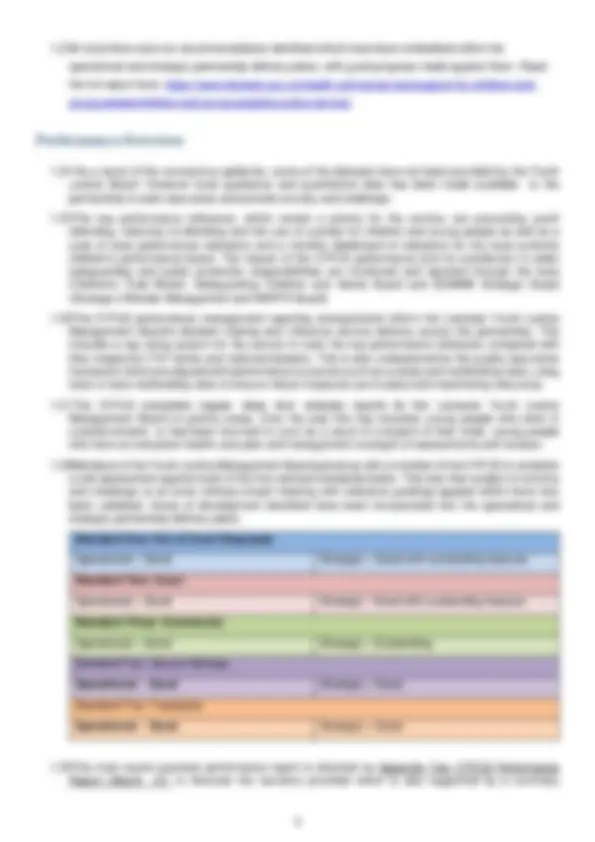






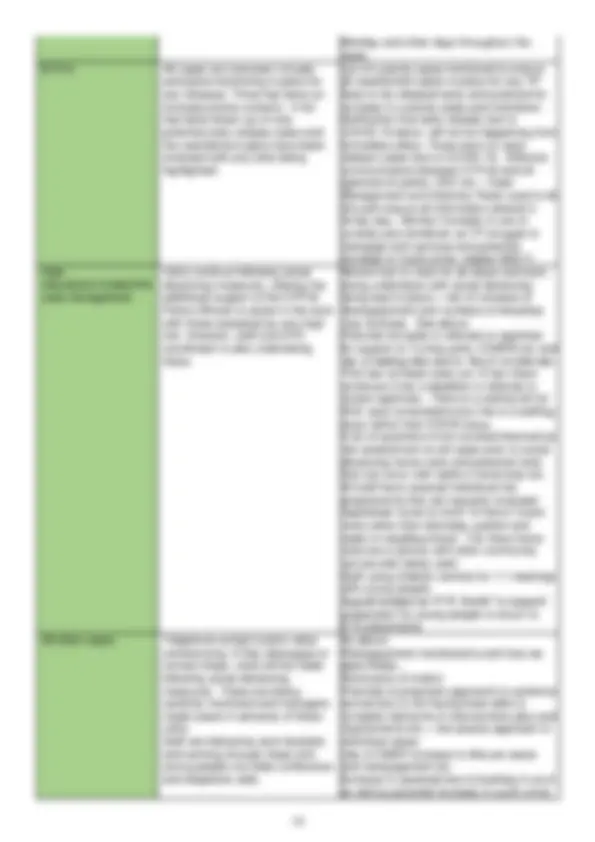
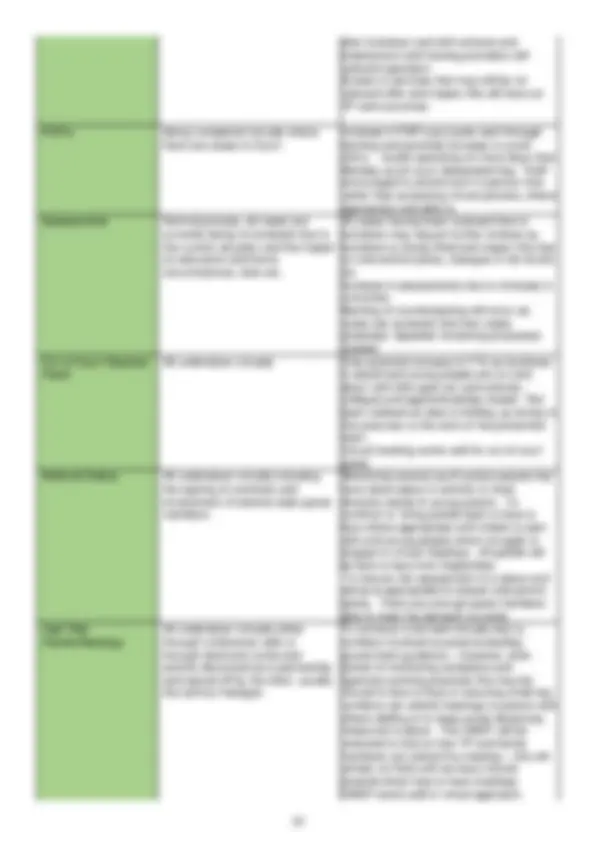

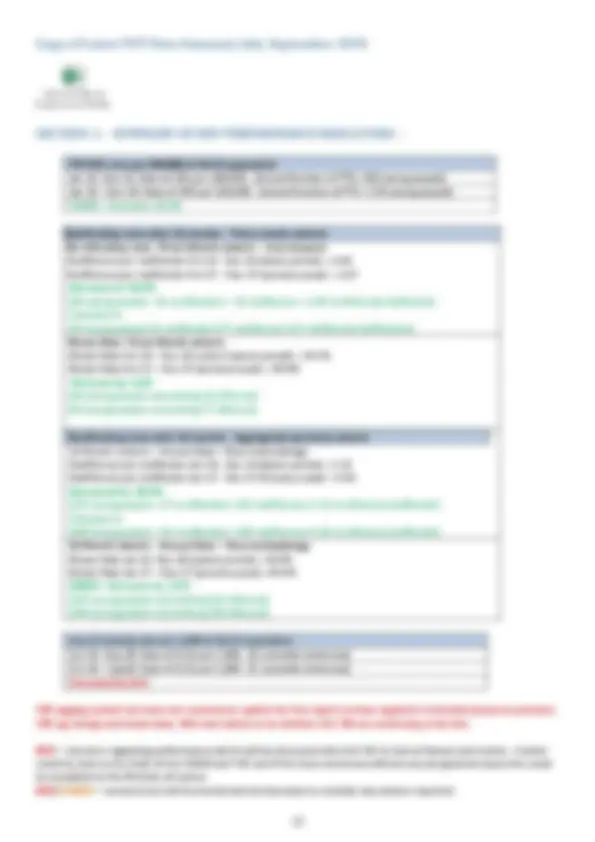
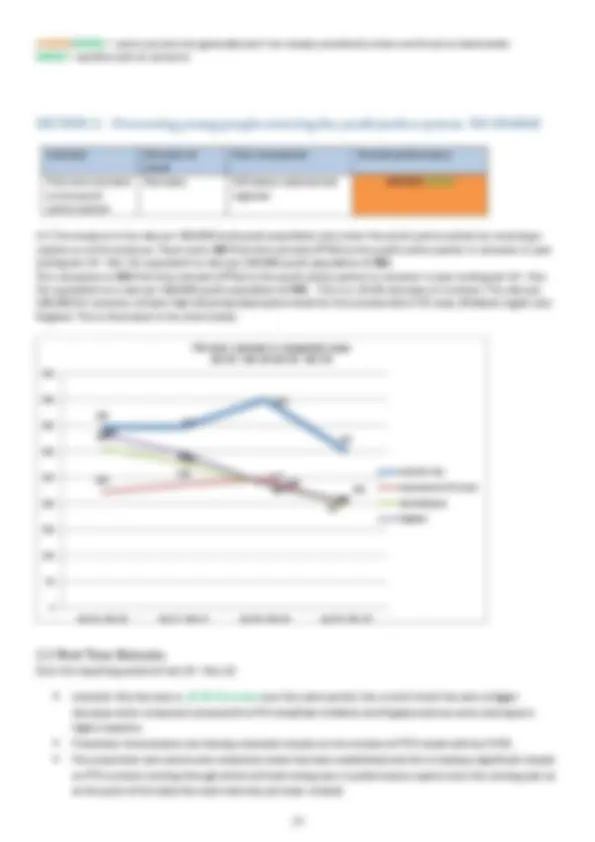

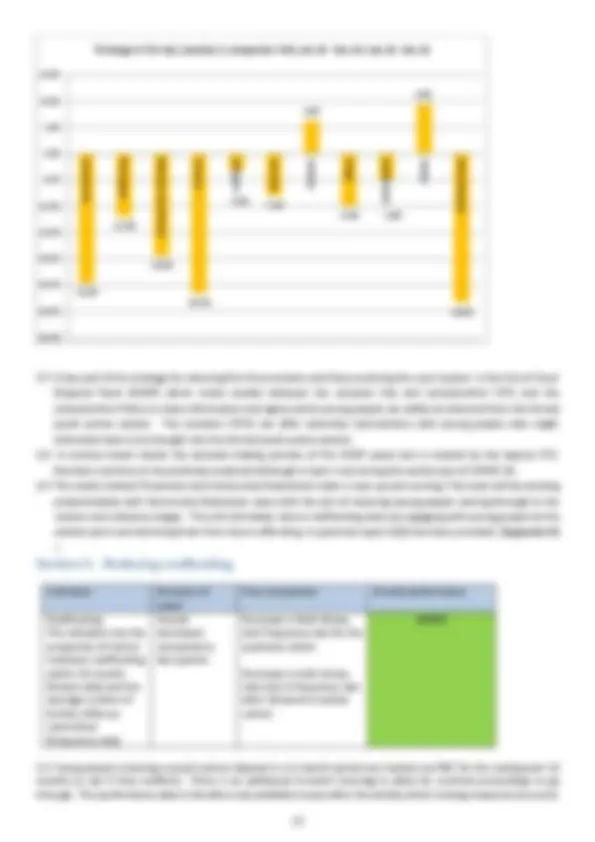
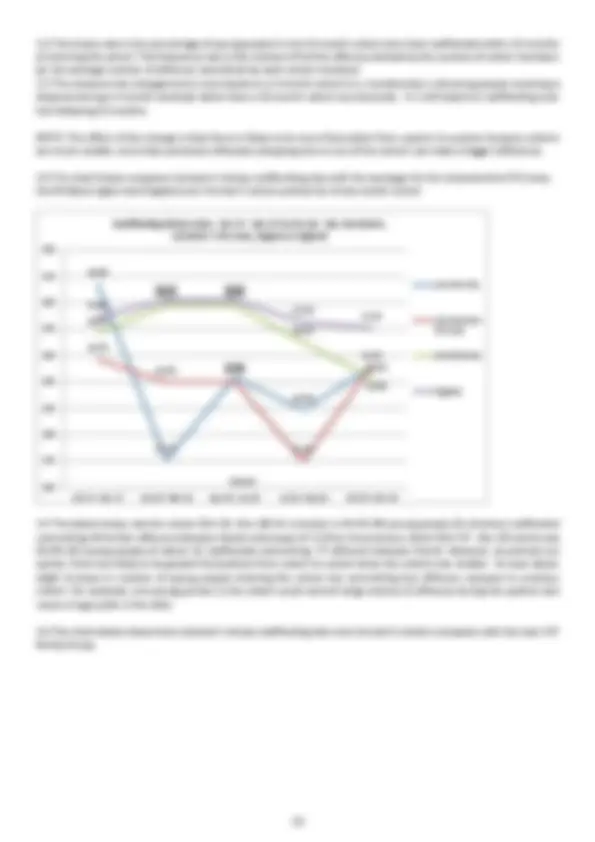

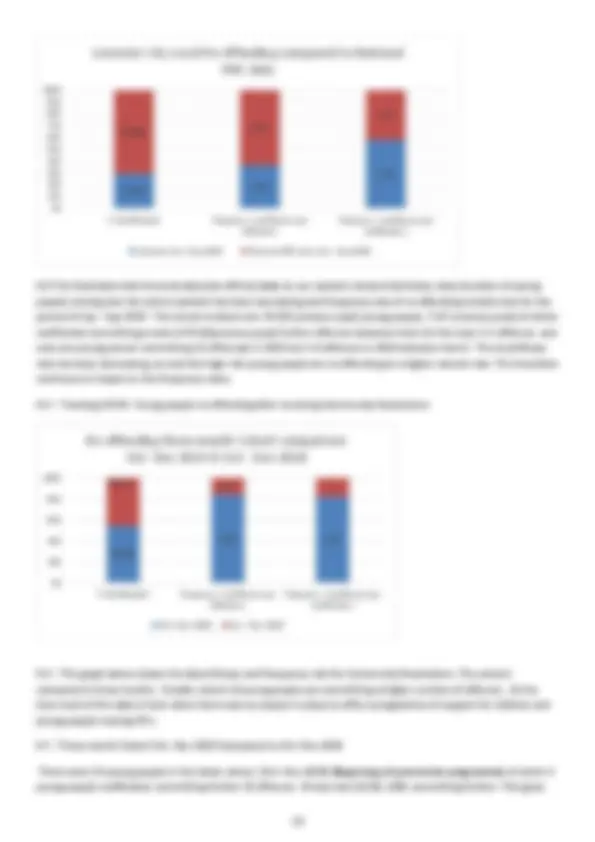
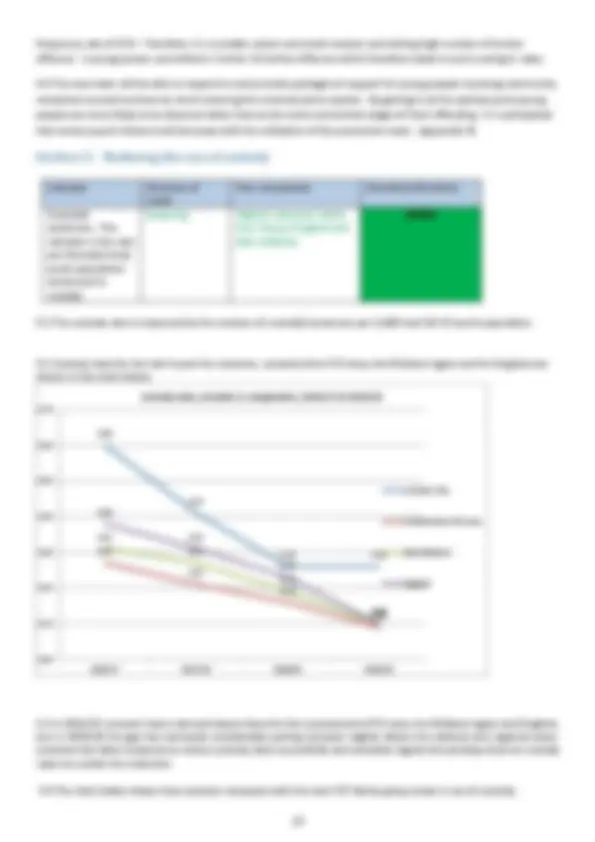
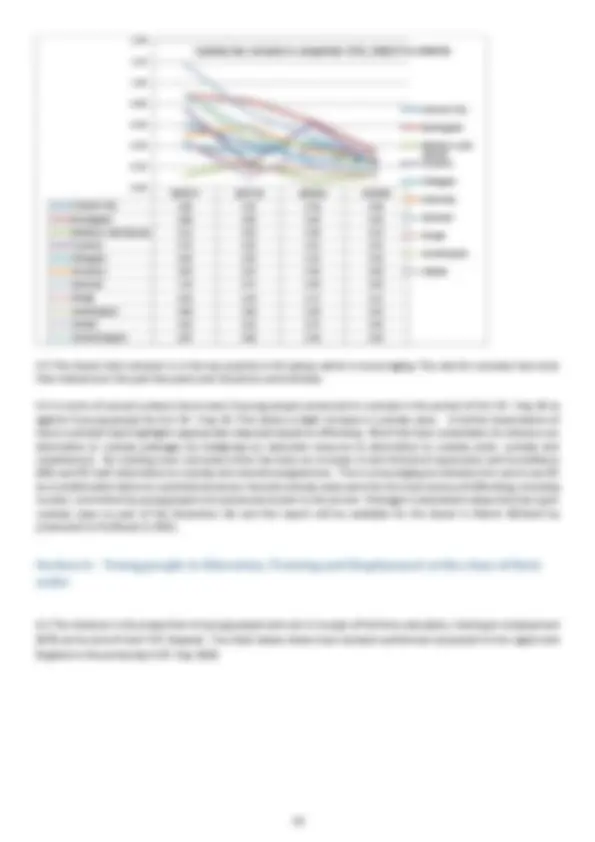
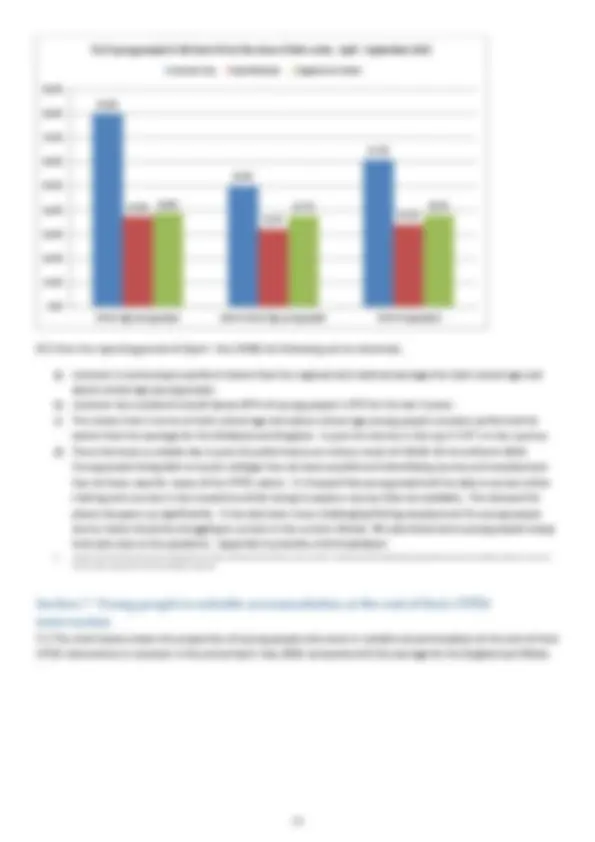
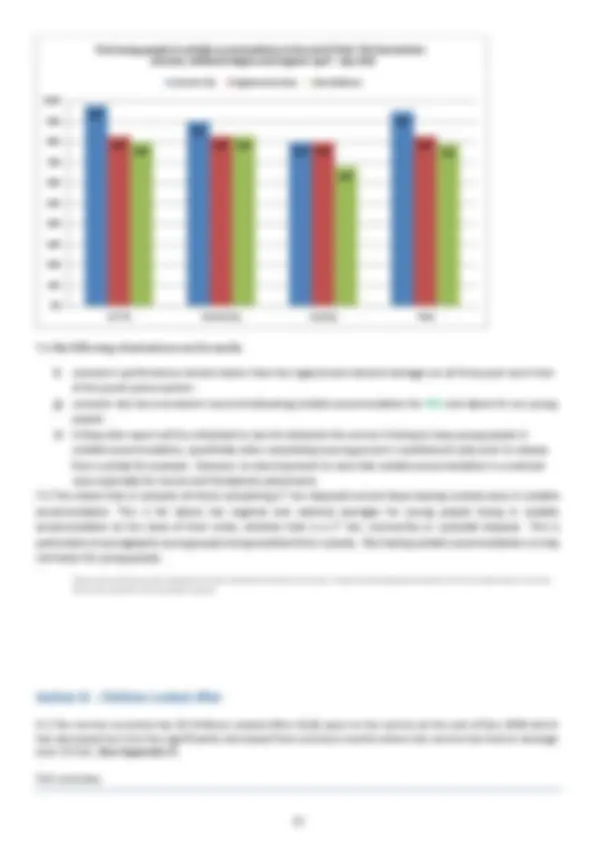





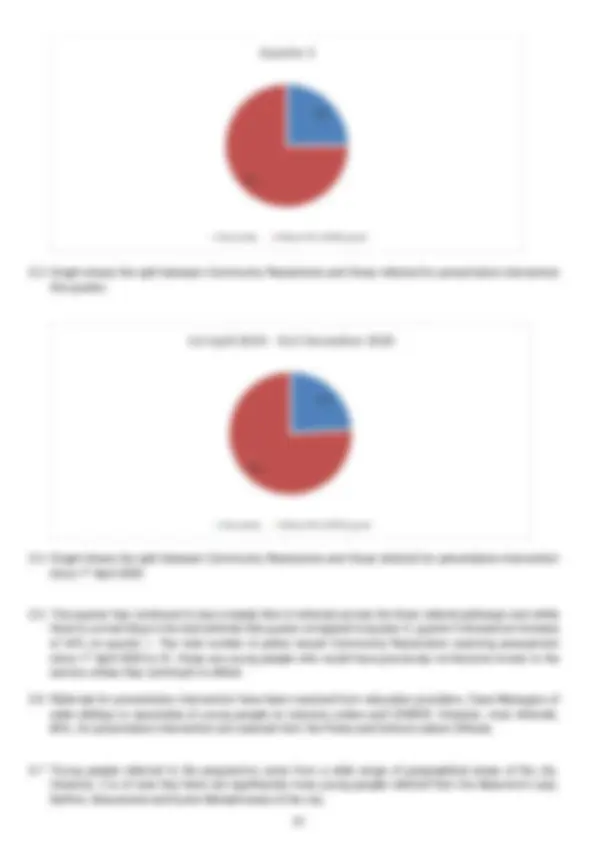

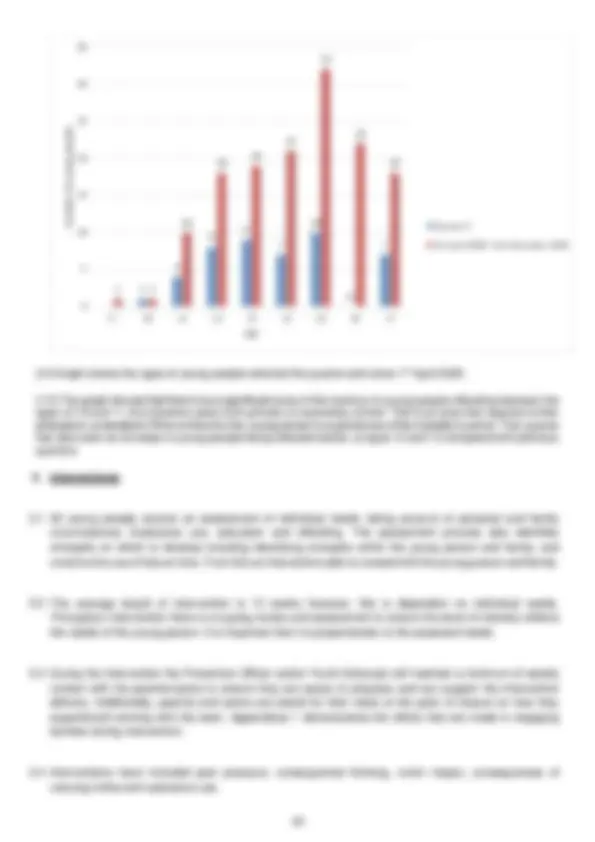

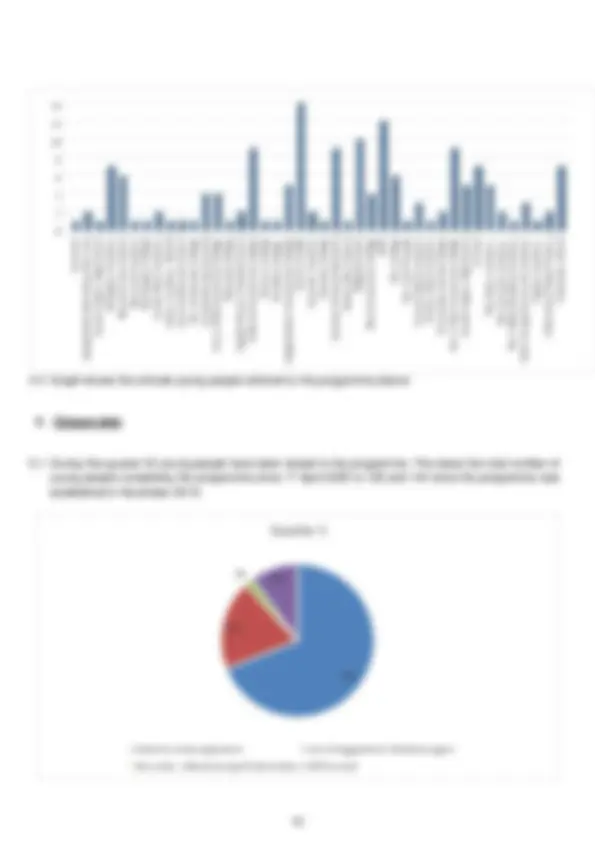
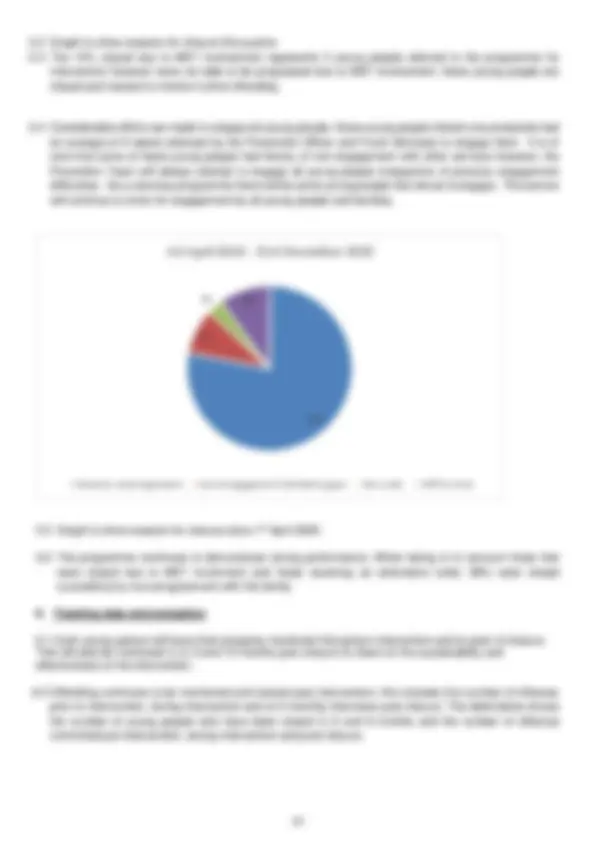












Study with the several resources on Docsity

Earn points by helping other students or get them with a premium plan


Prepare for your exams
Study with the several resources on Docsity

Earn points to download
Earn points by helping other students or get them with a premium plan
Community
Ask the community for help and clear up your study doubts
Discover the best universities in your country according to Docsity users
Free resources
Download our free guides on studying techniques, anxiety management strategies, and thesis advice from Docsity tutors
An analysis of the performance of the Leicester Children & Young People’s Justice Service (CYPJS) in preventing youth offending, reducing re-offending, and reducing the use of custody for children and young people. It includes data on the number of young people reoffending, the impact of earlier intervention, and the importance of good partnership working to prevent unnecessary escalation of looked after children and young people through the justice system. The document also discusses the specific needs of children and young people with special educational needs (SEN) and/or an education, health and care plan. Additionally, the document includes information on the CYPJS budget and staffing structure.
Typology: Study notes
1 / 53

This page cannot be seen from the preview
Don't miss anything!














































a) to divert children and young people away from crime and the criminal justice system. b) to engage young people on the cusp of offending, or who have received a community resolution for committing a low-level offence, to divert them away from the formal justice system. c) prevent the escalation of offending and serious youth violence and reduce the need for statutory services and resources eg) police, probation etc. 1.10 All children and young people known to the service, regardless of their offending, receive one to one intervention on knife related offending and consequences. These have been well received across the service and partnership and the service has maximised the funding received from the Office of the Police Crime Commissioner, to create bespoke group work packages in partnership with Targeted Youth Support services. The packages have concentrated on two distinct groups of young people targeting those at risk in a prevention project as well as those appearing on the habitual Knife Carrier list in reducing further offending. 1.11 The ACE project has provided ongoing training over the last year to all staff including sessions at the CYPJS service meetings as well as a focus on supporting the emotional wellbeing of staff. The project provides training, consultation and advice as well as direct work with young people and their families. The project team receive on average 3 direct referrals a month to support children, young people and families displaying trauma from their childhood. The project has more recently provided case formulation support which has enabled case managers to map and respond to childhood trauma. 1.12 Over the last year, the service has incorporated learning from a domestic homicide review and a MAPPA learning review within 2019 involving two young people who were open to the service. Recommendations for CYPJS have been shared with the Leicester Youth Justice Management Board with learning identified incorporated within the service delivery plan. At the time of writing this report, the domestic homicide review has not been formally published. 1.13 Targeted individual advice and guidance continues to be offered to our vulnerable children and young people who are not in education, training or employment (EET) CYPJS continues to support young people’s access to education, training and employment with some excellent results with the service being the in top five youth offending teams in the country for performance with over 80% of young people who are statutory school age, in education and training at the end of their involvement with the service, compared to 38% across the East Midlands and 40% nationally. However, the numbers of young people post 16 within EET have fallen from 79% to 50% in the most recent reporting period. This can directly be attributed to young people becoming unemployed or post 16 provision closing as a result of the coronavirus epidemic. That said, the Connexions Service continues to work with economic regeneration partners to ensure that Education, Training and Employment for young people open to the CYPJS remain a priority. There is a new development planned within 2021 for a bespoke employment hub to be located within the city which will help improve EET outcomes for young people aged 16+. (Based on quarter one figures). 1.14 The service is a key partner within the partnership response to serious organised crime and gang related offending in Leicester. The service is a key partner within the sub regional Child Criminal Exploitation hub for Leicester, Leicestershire and Rutland. The multi-agency response to criminal exploitation with a referral pathway and practice guidance for practitioners has been critical in ensuring the right responses are made at the right time for children and young people vulnerable to exploitation. 1.15 The service has worked in partnership with key agencies such as children’s social care, targeted youth and the police to embed a localised protocol and approach to continue to reduce the over- representation of children looked after (CLA) and care leavers within the criminal Justice system. Through concerted partnership work, whilst Leicester is still slightly above the national average/ YOT comparator group, there has been a significant reduction of CLA in the last 18 months (23 young people to 12 young people. However, the partnership is not complacent and is committed to maintaining this as a priority moving forward. At the time of writing this report, of the 12 young people open to the service who are CLA: o 8 out of 12 young people have reoffended, however this is a decrease compared with the previous reporting period
o more young people became CLA whilst on an order compared to last quarter. o More CLA young people have committed lower gravity score offences and have received more first tier and community orders. o Violence against the person is committed more often in this group of CLA young people 1.16 The Service Manager ensures all CLA are scrutinised through the QA process. The Head of Service for Corporate Parenting led a piece of work in the summer to explore if there was any disproportionality within the CLA cohort with findings and recommendations presented to the board. The task and finish group reviewed the cohort of open cases of children looked after who were identified by the CYPJS in the 12-month period between 01 April 2019 and 31 Mar 2020. This contained 28 young people who had a looked after status and were recorded as being known to the CYPJS, however 20 of these young people had received an out of court disposal with a caution or community resolution. Key findings are summarised as follows: a) analysis of the cohort did not identify any inappropriate sentencing or causation in the over representation of LAC in the local CYJS. Locally trends in the numbers of children looked after have stabilised and reduced in some categories over the past 12 months so it should be identified that there is a corresponding reduction in the numbers of LAC known to the CYPJS over the most recent period from 1 April 2020 to 31 Mar 2021. b) the lives of children and young people who enter the youth justice system are complex and often involve early childhood trauma and adverse experiences which can have an impact in their later adolescent and adult lives. Many of the children and young people in the sample had experienced difficulties with school attendance prior to coming into care and had direct or indirect experience of poor mental health and of being at risk of criminal exploitation. c) there is clear evidence even within this relatively small cohort of the importance of good partnership working at an operational and strategic level to prevent the unnecessary escalation of looked after children and young people through the justice system and to ensure that early help and prevention services are offered prior to children reaching the age of criminal responsibility and then for additional targeted support to prevent escalation through the justice system. 1.17 Recommendations identified and incorporated within the CYPJS service plan include: o the previous joint protocol between the CYJS and Children’s Social Care is revised and updated. o children looked after and known to the CYJS are reported to the CYJS Board and relevant partners on a regular basis to monitor trends in practice and performance. o offending by LAC continues to be reported to the Corporate Parenting Board by Head of Service. o on-going training in restorative justice is included in support for social care, health and Police professionals to ensure appropriate use of community resolutions and out of court disposals for looked after children.
c) Inconsistencies in processes being applied in practice with not enough focus on diversity and culture for in general. The staff survey and young people’s survey have also identified some key areas of development, some not in relation to ethnicity. d) Reviewing all of the findings, the task and finish group have developed 25 recommendations that have been incorporated into the CYPJS service delivery plan. These recommendations are divided into three key areas: o Improving quality of practice o Building capacity and confidence within the workforce o Active participation influencing planning and delivery
1.22 As a statutory regulated service, youth offending services are normally inspected every three years by Her Majesty’s Inspectorate of Probation (HMIP). The most recent single inspection took place in Aug 2019 with 10 inspectors over 5 days and compromised of focus group discussions with staff and partners, observations and casework. The inspection looked at each of the 12 standards below and produced an overall grading of GOOD demonstrating strength and ongoing improvements. (The previous inspection, although a different set of criteria and grades judged the service as satisfactory in 2016). HMIP Inspection Outcome for Leicester City Youth Offending Service
1.23 In total there were six recommendations identified which have been embedded within the operational and strategic partnership delivery plans, with good progress made against them. Read the full report here: https://www.leicester.gov.uk/health-and-social-care/support-for-children-and- young-people/children-and-young-peoples-justice-service/
1.24 As a result of the coronavirus epidemic, some of the datasets have not been provided by the Youth Justice Board. However local qualitative and quantitative data has been made available to the partnership to seek assurance and provide scrutiny and challenge. 1.25 The key performance indicators, which remain a priority for the service, are preventing youth offending, reducing re-offending and the use of custody for children and young people as well as a suite of local performance indicators and a monthly dashboard of indicators for the local authority children’s performance board. The impact of the CYPJS performance and its contribution to wider safeguarding and public protection responsibilities are monitored and reported through the local Children’s Trust Board, Safeguarding Children and Adults Board and SOMMB Strategic Board (Strategic Offender Management and MAPPA Board) 1.26 The CYPJS performance management reporting arrangements inform the Leicester Youth Justice Management Board’s decision making and influence service delivery across the partnership. This includes a rag rating system for the service to track the key performance indicators compared with their respective YOT family and national datasets. This is also underpinned by the quality assurance framework which are aligned with performance outcomes such as custody and reoffending rates, using tools to track reoffending rates to ensure robust measures are in place and maximising resources. 1.27 The CYPJS completes regular ‘deep dive’ analysis reports for the Leicester Youth Justice Management Board on priority areas. Over the year this has included, young people who were in custody/remand or had been returned to court as a result of a breach of their order, young people who have an education health care plan and management oversight of assessments and reviews. 1.28 Members of the Youth Justice Management Board paired up with a member of the CYPJS to complete a self-assessment against each of the five national standards below. This was then subject to scrutiny and challenge at an extra ordinary board meeting with indicative gradings applied which have now been validated. Areas of development identified have been incorporated into the operational and strategic partnership delivery plans. Standard One: Out of Court Disposals Operational – Good Strategic – Good with outstanding features Standard Two: Court Operational – Good Strategic - Good with outstanding features Standard Three: Community Operational – Good Strategic - Outstanding Standard Four: Secure Settings Operational - Good Strategic – Good Standard Five: Transitions Operational - Good Strategic – Good 1.29 The most recent quarterly performance report is attached as Appendix Two: CYPJS Performance Report (March 21 ) to illustrate the narrative provided which is also supported by a summary
1.31.3 To further reduce the frequency and seriousness of re-offending by first time entrants by earlier identification and assessment of first-time entrants, including young people subject to court orders. 1.32 Reducing Reoffending Performance for 20 20 - 21 1.32.1 As a result of a collaborative partnership response and new preventative initiates, Leicester has seen a decrease in both binary and frequency rates when compared to most of its YOT family groups which is encouraging. Due to the volatility of the smaller cohorts the changes in rates between cohorts vary considerably depending on which base-line cohort is used. The latest binary rate for cohort (Jan 18 - Mar 18) for Leicester is 27.1% (70 young people-19 of whom reoffended committing 74 further offences between them) a decrease of - 5.67% on the previous cohort (Jan 17 - Mar 17) which was 32.8% (64 young people of whom 21 reoffended committing 109 offences between them). Therefore, whilst there is a slight increase in the number of young people entering the cohort, they are committing less offences compare to previous cohort. 1.32.2 The service has used a live tracking tool to take a strategic overview of the whole cohort and ensure the right actions are taken for the right young people at the right time. By ensuring a local tracking system is in place for young people entering the local cohort we can get a more up-to- date indication of local performance. This illustrates that the local data (not official data) on our systems for both the binary and frequency rates have reduced. 1.32.3 Comparing local data from when there was no prevention team within the CPYJS has evidenced: Three-month Cohort Apr - June 2019 (Community Resolutions) o There were 10 young people in the latest cohort, (Apr – June 2019) where there was no prevention programme on offer at that time). Of the 10 young people, 1 young person reoffended, committing a further 11 offences. Binary rate was 1 out of 10 young people which equated to 10% committing further offences. This gives frequency rate of 1.10 which highlights it’s a smaller cohort with a small number of young people committing a high number of further offences. Twelve-month Cohort- April 2019– March 2020 o The Prevention Programme started Nov 2019. There were 59 young people in the latest cohort, (April 2019 – March 2020) of which 6 young people reoffended, Binary rate (6 out of 59 ) which equates to 10.2% committing a further 17 offences (1 young person committing 11 further offences and 5 committing 1-3 offences) between them. This gives frequency rate of (17/6) = 2.8. 1.32.4 The number of young people receiving community resolutions has increased (and will continue to do so with a percentage of the cohort already open to the service on statutory orders and persistently re-offending. However, from our data evidences that the number of young people re- offending is declining since the prevention programme came into place with most young people committing between one and three offences between them. This is an encouraging picture and highlights the impact of getting in early to work with young people before they get entrenched in offending by targeting those who aren’t persistent and already on statutory orders. 1.33 Reducing Reoffending Priorities for 20 21 - 22 1.33.1 To confidently articulate the impact of reoffending rates over the coming year due to tracking a smaller cohort and the likelihood of bigger swings in the percentage rates of offending. This will then enable the CYPJS and partnership to respond effectively, using local up to date knowledge to inform planning and delivery. 1.33.2 As per 1.31.2, expand the Community Resolutions and Prevention Team to focus specifically on the prevention and protection of young people who are criminally exploited and re-offending. Arrest data, education records and social care records alongside evidenced based approaches will be utilised in tracking outcomes post intervention to monitor the effectiveness interventions. This will evidence and inform the desired trajectory for permanent resources to be positioned at an earlier stage within the CYPJS which may lead to a reorganisation of resources at a later stage. However,
this will need to consider the severity of offences of young people which require more intensive support from case managers. 1.33.3 To continue to reduce the frequency and seriousness of re-offending by young people known to CYPJS at first tier interventions, where statistically this remains a challenge both locally and nationally. 1.33.4 As part of the ACE project with NHS England, continue to prioritise and address the area of trauma and emotional trauma in the lives of young people. CYPJS staff have received specialist training to identify and respond effectively to emotional trauma which has strengthened support plans for children and young people as well as a greater understanding for victims of youth crime about the experiences for some young people. At the time of writing this report, the current model is funded until March 2021, it is hoped this will continue as it has been of significant benefit to both staff and young people, contributing to the reduction of young people requiring specialist CAMHS intervention. 1.33.5 The service has worked closely with SEND and SES colleagues to enhance staffs understanding and use of EHCP’s. This has involved training and developing a bespoke panel for staff to receive support when working with young people who hold an EHCP or indeed where specialist support is sought. The service will continue to prioritise this area and develop the support needed for children with identified needs. 1.33.6 The early identification and intervention through the Police issued Community Resolutions and referrals for prevention intervention will continue to impact upon FTE’s. These young people would have had to continue offending or have committed more serious offences before coming to the attention of the service and receiving support. It is well documented that earlier intervention has a greater impact rather than delaying interventions until young people are more entrenched in offending behaviours. Additionally, the team is working with Case Managers across the service to identify siblings of those young people on statutory orders and known associates who may be at risk of becoming involved in criminality. The case management and diversity panel is actively looking at siblings of the most serious offenders to ensure wrap around services are provided and timely referrals made. 1.34 Reducing the Use of Custody Performance 20 20 - 21 1.34.1 Leicester has taken measures to reduce custody rates successfully and over the last year has maintained the highest reduction of young people receiving a custodial sentence in comparison with their YOT family and national rates with Leicester in the top quartile in this group. 1.34.2 A deep dive on all seven young people in custody was completed in December which identified good practice in relation to planning, resettlement and regular contact. The local resettlement police will be reviewed within the first quarter of this year. 1.34.3 Social care are regularly attending remand strategy meetings and the Service Manager is overseeing numbers of remands in police custody and ensuring information is shared with the Head of Service and Director on a monthly basis. Through the police custody remands meetings, professionals come together to scrutinise monthly data and assess decision making with good congruence rates. However, there is more work to do as part of the development of a Remand Strategy to fully consider alternatives. 1.34.4 In terms of actual numbers there were 9 young people sentenced to custody in the period of July 2019 – June 2020 compared with 7 young people for the 12 months prior. A further examination of those custodial cases highlights appropriate disposals based on offending. Work has been undertaken to enhance our alternative to custody packages by realigning our advocate resource to alternative to custody work, custody and resettlement. By tracking court outcomes there has been an increase in bail Intensive Supervision and Surveillance (ISS) and ISS both alternative to custody and remand programmes. This is encouraging as indicates the courts see ISS as a
1.37.4 The CYPJS is positioned within the Social Care and Education Department of the Local Authority. The service is strategically overseen by the Head of Service for Early Help and Prevention which has a portfolio of services including the Early Childhood services, Family Support, Youth Services, Multi Systemic Therapy and the CYP Justice Service. This approach contributes to a co-ordinated whole family response supporting earlier identification of families with multiple and complex needs together with increased opportunities for more targeted work with children and families at risk of poor outcomes or involved in crime and anti-social behaviour. 1.37.5 The Service Manager oversees the operational delivery of the service and partnership work under the management of the Head of Service. The Head of Service is managed by the Director for Social Care and Early Help who reports directly to the Strategic Director for Social Care and Education. Governance arrangements for CYPJS reside with the multi-agency Leicester Youth Justice Management Board (LYJM Board) chaired by the Strategic Director for Social Care and Education. 1.37.5 The Head of Service recently left their post in February 2020, a new Head of Service has been appointed and is due to start in mid-march 2021. Their background is youth offending therefore bringing a wealth of experience to this role which will be key to the implementation of the annual plan. 1.37.6 The LYJM Board has senior officer level representation from statutory services including Police, Health and the National Probation Service. (Refer to LYJMB Membership and Terms of Reference Appendix Two) Representation is also in place from Education/SEND, Safer Leicester Partnership and Community Rehabilitation Company. A key focus of the board over the last year has been strengthening the strategic response and shared ownership of the partnership strategic plan alongside ensuring services are effective in light of the challenges the coronavirus epidemic has brought. The board also commissioned two discreet pieces of work exploring disproportionality of ethnicity and children looked after within the CYPJS cohort. Refer to Appendix Three: Leicester Youth Justice Management Board Terms of Reference 1.37.7 Most notably, the development of the Violent and Complex Crime Unit within Leicestershire Police has resulted in an increased focus investing in prevention, aligned with the priorities of both the LLR Violence Reduction Network and Leicester annual youth justice plan. 1.37.8 The board meets on a quarterly basis where performance and finance reports are presented by the Service Manager, to inform strategic decisions and resource allocation. A strategic partnership action plan is overseen by the board HM Courts are kept abreast of the performance and governance through the Service Manager chairing quarterly liaison meetings with the courts. 1.37.9 The board reports include quarterly analysis of performance against key national and local youth justice indicators, audit and self-assessment activity, Serious Incident reporting, National Standards audits; and quarterly YJB monitoring reports. The board reviews and revises its performance management framework on a regular basis, to take into account best practice and changing local and national priorities. Ongoing strategic partnership analysis and priorities for 20 20 included child sexual exploitation (CSE), mental health, disproportionality, and serious youth offending. 1.37.10 The effective participation and engagement of children and young people continue to be a high priority for the service. The Service Manager has (through a task and finish group made up of colleagues from the service) developed an addendum to the Social Care and Education Participation strategy that specifically focuses on the service response to ensuring effective co- production with young people and their families in their assessments, plans and interventions. 1.37.11 The Head of Service is a member of key governance groups linking to LYJMB such as the Strategic Offender and Mappa Management Board (SOMMB), Local Safeguarding Partnership Board for reporting and monitoring lessons from Serious Incidents and Child Practice Reviews. The Director for Social Care and Early Help is the chair of the Early Help Strategic Partnership Board which is a subgroup of the Leicester’s Children’s Trust. The Head of Service has lead responsibility for delivering against the ‘Early Help’ strand of the SOMMB delivery plan for Leicester Leicestershire and Rutland. This has evidenced great progress being made within the city in particular for the prevention and protection of young people who are criminally exploited and at risk
of offending and re-offending. The Service manager deputises for the Head of Service and ensures attendance at all operation delivery groups that sit beneath the strategic boards. 1.37.12 The Service Manager also holds quarterly liaison meetings with key partners and stakeholders including the Police, Courts, CAMHS, Turning Point (substance misuse provider) etc.
1.38 The YJB Youth Justice Grant allocation focusses on innovation and service improvement and supports the annual partnership delivery plan reviewed by the Leicester Youth Justice Management Board. This ensures resources continue to be prioritised in areas where there are risks to future delivery and performance. 1.39 Service improvement activity in 20 20 - 21 has been ongoing through the use of the YJB Re-offending Toolkit to ensure a more detailed understanding of local re-offending rates ensure the frequency rates are targeted more effectively by the management team. Attendance by the police and the Integrated Offender Manager has enabled the sharing of real time intelligence for case managers to respond to reducing drift and delay in refreshing assessments and pathways and planning. The Service has fully embedded this toolkit within its weekly management reoffending toolkit meetings. The InfoPath tool is embedded within quality assurance processes with over 80% of assessments regularly graded as good 1.40 Funding contributions from statutory partners in Health and the National Probation Service are yet to be confirmed for 20 21 - 22 at the time of writing this plan, however it is envisaged these will remain at the same levels. The OPCC has confirmed 20 21 - 22 core funding for the service. Additional funding has been secured from the Troubled Families payments by results, the Violence Reduction Network in Leicester and OPCC to support the CR and Prevention Team to continue for the year ahead. Funding amounts are still in the process of being determined therefore the team may be reduced if full funding is not secured. A table containing the financial, staffing and in-kind contributions made by local partners is contained in Appendix Three for 20 21 - 22. 1.41 The service is supported by seconded staff as follows: o 1 FTE Probation Officer o 2 FTE Police Officers o 1 FTE Pre- 16 Education Specialist o 1 FTE Post 16 Education Co-ordinator. 1.42 The service continues to work closely with the Child and Adolescent Mental Health Service (CAMHS) with direct support from a CAMHS Practitioner on a part time basis. In Addition, two practitioners working across LLR offer support for the trauma induced work, staff have been using their training to support their work with children and young people that display acute childhood trauma (ACE’s). 1.43 Additional resources for the service include dedicated Educational Psychologist time and a dedicated Education, Training and Employment Personal Advisor surgery from the Connexions Service. 1.44 The CYPJS has a diverse workforce that reflects the diversity of the local communities that it serves. The entire workforce is employed on a permanent basis, apart from the CR and Prevention Team. Whilst there is an underrepresentation of female employees in all parts of the service apart from management, there has not been any detrimental impact on front line service delivery specifically towards our female service users that may require female practitioners. However, this will continue to be an area that we monitor and do not feel this will be problematic as the local demographic of the cohort of young people we are working with are predominantly male which is reflective of our workforce for both gender and ethnicity. 1.45 Through our disproportionality of ethnicity work, we identified an underrepresentation of managers who are black, asian or of another ethnicity. As YOT staffing structures tend to be more stable with
represented include Connexions, CAMHS, substance misuse and parenting workers to ensure that young people’s safeguarding, risk of harm, welfare and mental health needs are appropriately assessed. Parenting support is provided to all young people in custody and their families throughout the custodial sentence to plan and support reintegration into the community. Other key professionals will be invited depending on the specifics of each case being presented to the panel.
1.51 Although this year has certainly brought more challenges, the service has continued to be innovative with a number of achievements to be proud of. The following outlines some of the examples of success: o The service has embedded a robust offer to young people who have experienced Acute Trauma (ACE) in their lives and how to support young people with a history of trauma. o Embedding the groupwork programme ‘ Which Way’ focus on reduction of reoffending. Refer to Appendix Seven: Which Way Programme Evaluation Quarter Three Oct – Dec 2020 o Development of a localised approach and strategy embedding the ‘Lundy Model’ as an effective way of engaging children, young people and their families in influencing service delivery and design. This has also led to improvements with young people knowing why the service is involved with clear evidence of engagement within assessments and plans. o Focussed deep dives through task and finishing groups, exploring disproportionality and unconscious bias within the CYPJS cohort in relation to ethnicity and children who are looked after. o Innovative and creative response to the coronavirus pandemic, ensuring that children and young people were fully supported. o Developed a robust approach to working with children and young people on EHCP’s to ensure staff are skilled and able to adapt plans to meet identified needs. Staff were trained and a panel set up for staff to gain consultation on specific cases via SES and educational psychologists. o Establishing the Community Resolution and Prevention using evidenced based practice to secure outstanding results, particularly in the prevention of young people becoming first time entrants and a reduction in further offending for young people who receive a community resolution. Refer to Appendix Four: Community Resolutions and Prevention Team Quarter 3 2020 - 2021
1.52 A key risk at the time of finalising this plan is the continued impact of the coronavirus pandemic. Whilst the CYPJS is operational in line with government guidance, there are some restrictions in place such as the suspension of face to face contact with young people in custodial establishments and a potential increase in court proceedings being delayed. This alone will see an increase in workload for the service once services resume as they were. The service has a business continuity plan in place with a robust response to COVID-19 to ensure all risks are considered and mitigated against. This is regularly reviewed and will inform service delivery moving forward. Refer to Appendix One: Leicester CYPJS Response to CV- 19 1.53 An ongoing challenge for the CYPJS is to maintain continuous improvement in the context of any proposed national changes. Additional risks to future service delivery arise from reduced government and partnership funding.
1.54 The service is working with strategic partners through the YJMB to ensure that national changes to the criminal justice system through Police, HM Courts and Probation services are managed appropriately and address risk, public protection and safeguarding priorities for young people.
1.55 Key priorities for the Leicester Youth Justice Management Board for 20 21 - 22 include areas for development highlighted by the HMIP inspection and self-assessment against the Youth Justice Board national standards. Some of the priorities from the 2020-2021 plan have also been rolled forward as a result of ongoing work required which was impacted by the coronavirus pandemic.
Monday and other days throughout the week. DTO’s All cases are overseen virtually and plans/monitoring in place for any releases. Three has bene an increase phone contacts. A list has bene drawn up on any potential early release cases and the resettlement plans have been reviewed with any risks being highlighted. List of custody cases monitored to ensure all resettlement plans in place for any YP likely to be released early and potential for increase in custody cases post-lockdown. Notification that early release due to COVID-19 alone will not be happening from immediate effect. There were no early release cases due to COVID-19. Effective communication between CYPJS and all agencies ie police, CSC etc – Case Management and Diversity Panel used to do this and ensure all information shared in timely way. Monitor increase in use of custody post lockdown as YP struggle to reengage with services and potential increase in Youth crime (higher NEET). High Risk/ISS/DTO/MAPPA case management Visits continue following social distancing measures, utilising the additional support of the CYPJS Police Officers to assist in the work with those assessed as very high risk. However, staff and DYO coordinator is also undertaking these. Moved now to visits for all cases and work being undertaken with social distancing being kept in place – risk of increase of disengagement and numbers of breaches may increase. See above Potential increase in referrals to agencies for support ie Turning point, CAMHS etc and risk of waiting lists due to “flood” of referrals. This has not been seen yet. In fact there continues to be a deadline in referrals to certain agencies. There is a waiting list for ACE case consultations but this is a staffing issue rather than COVID issue. A list of questions to be covered/checked as risk assessment on all cases prior to social distancing home visits and potential visits that can occur with walks in local area etc All staff have received individual risk assessments that are regularly reviewed. September move to more “in home” home visits rather than doorstep, garden and walks in neighbourhood. Tier three home visits are a priority with other community venues also being used. Staff using children centres for 1:1 meetings with young people. August badged as “ETE Month” to support preparation for young people to return to ETE placements All other cases Telephone contact and/or video conferencing. If they disengage or contact drops, visits will be made following social distancing measures. These are being carefully monitored and managers made aware in advance of these visits. Staff are delivering work booklets and working through these with young people via video conference and telephone calls. As above Reengagement mechanisms and how we apply these… Revocation of orders Potential of pragmatic approach to sentence served due to not having been able to complete elements of interventions plan and requirements etc – risk assess approach in individual cases Use of CMDP increase to discuss cases and reengagement etc Increase in caseload due to backlog in court as well as potential increase in youth crime
after lockdown and with schools and employment and training providers still reduced operation. Access to services that may still be on reduced offer and impact this will have on YP and outcomes. PSR’s Being completed virtually where there are cases in Court. Increase in PSR’s as courts work through backlog and potential increase in youth crime… courts operating on more days than Monday youth court designated day. Staff encouraged to attend court in person now rather than accessing virtual process, where appropriate and able to. Assessments Normal process, all cases are currently being re-reviewed due to the current situation and the impact on education and home circumstances, risks etc. All cases having been reviewed due to lockdown may require further reviews as lockdown is slowly lifted and impact this has on intervention plans, changes in risk levels etc Increase in assessments due to increase in outcomes. Backlog of countersigning will occur as cases are reviewed and new cases assessed. Speedier reviewing processes needed. Out of Court Disposal Panel All undertaken virtually Only potential increase in FTE as lockdown is eased and young people are out and about with little open etc and schools , colleges and apprenticeships closed. Not been realised as data is holding up strong in this area due to the work of the prevention team. Virtual meeting works well for out of court panel. Referral Orders All undertaken virtually including the signing of contracts and involvement of referral order panel members. Monitoring several youth justice panels that have taken place in centres to meet diversity needs of young person. To continue to bring panels back to face to face where appropriate with initials to start with and young people whom struggle to engage in virtual meetings. All panels will be face to face from September. To ensure risk assessment is in place and venue is appropriate to ensure everyone’s safety. There are enough panel members able to meet the demand currently. High Risk Panels/Meetings All undertaken virtually either through conference calls or through electronic notes and actions discussed as a partnership and signed off by the chair, usually the service manager. To continue to be held virtually due to numbers involved at panel exceeding government guidance – However, after period of monitoring workplace and agencies working practices this may be moved to face to face or ensuring small key numbers can attend meetings in person with others dialling in to keep social distancing measures in place. The CMDP will be reviewed to look at how YP and family members can attend the meeting – this will remain on hold until we have moved towards direct face to face meetings. CMDP works well in virtual approach.